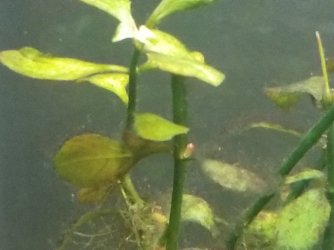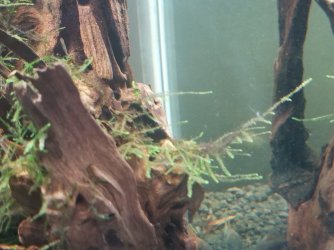IR_Crayoneater
New Member
So I have been having this issues going on for about 2-3 months now. It started out as just little hairs on some of my plants and now it has spread throughout my whole tank. I believe its black hair algae but I could be wrong and I havent been able to identify what is on the spiderwood. It started in my 30gal tank and then in July I upgraded that tank to a 55 and added some more plants and that Monte Carlo you see that looks half dead across the bottom of the tank (still trying to get the needs for it hashed out).
The first 4 pictures are taken from left, middle-left, middle-right and right side of my tank to show its throughout the whole tank. The spiderwood in the 5th picture has a grayish/white hair algae growing on it pretty significantly.
DETAILS: I do a 20% water change every week along with a 2.5 gal addition (from evaporation), I use 2mL of Prime in each 5 gal bucket during water changes. I have an aqua clear 70 and 55 filter set up on the tank. The 70 has sponge, amino-carb, bio filter, 1/4 cuttlefish bone and small bag of crushed coral. The 55 has sponge, carbon and bio filter. 1 12" airstone. I dose with API quickstart every 2 weeks, Flourish & excel every 3 days and aquarium 1.5 Tablespoons of aquarium salt once I hit 90% of the water changed. I change the crushed coral once a month also. I feed flake food, 1 algae disk and 5 sinking pellets every other day, on the opposite day its flake food, either a blood warm or Brine cube, 1 algae disk. Oh, and API root tabs is something new I have done in the last month, 5 tabs every 2 weeks spread throughout the tank.
INHABITANTS: 1 Clown Pleco, 2 Platies, 3 Corys, 3 Clown Loaches, 2 Mystery Snails, 2 Fiddler Crabs and usually 2 Mollies BUT at the moment 6 Mollies because one just gave birth and they are not big enough to rehome yet. Ghost Shrimp I dont count because they get eaten within 2-3 weeks of placing in the tank, mainly just a food source. Yes I know the tank is overstocked.
PLANTS: If I remember correctly, the driftwood is Malaysian, Spider and some piece I got from Vietnam that I cant remember the name of for the life of me. I have Java Moss, Monte Carlo, Hornwort, Amazon Sword, Anubias etc.
PARAMETERS: PH- Steady between 7.6-7.8, Ammonia-0, Nitrite-0, Nitrate-Steady between 0-15 ppm, GH&KH-110-125ppm ( I know this is soft my tapwater is extremely soft thats why the coral is in the tank) Temperature- between 80-82 degrees Fahrenheit.
LIGHTING: I have a timed Blue, RGB, LED Aqueon 55" light. The blue light turns on 10AM and turns off 12 PM, RGB and LED turns on at noon and shuts off at 10pm.
WHAT I HAVE DONE: I read about CO2 levels could be cause so I started dosing with Excel, 2 weeks ago I removed the spider wood with the white stuff on it and dipped it in 3 gallons of water with 3 tablespoons of 3% Peroxide in it. 5 Dips, 10 seconds each. It seemed to work for a few days then the stuff grew back. I have removed the spiderwood numerous times and scraped it then hosed it off outside the tank. My tank use to be full of plants, but as you can see I have murdered them from trimming off any part with the algae on it to the point where I think I may have killed some of them. I have cleaned my filters out thoroughly, clean the glass every 2 days with pads. I have thought of doing a total blackout on the tank for 24 hours because part of me believes excess lighting could be the issue. The tank sits at a 45 degree angle from a window that has sunlight coming through it when it sets. I doubt this matters because of the type of light, but it also sits adjacent to the TV in the living room approx 13-14 feet away that is usually on till midnight. The living room light is shut off typically at 8PM when my wife sits down because she is apparently nocturnal with night vision.
The first 4 pictures are taken from left, middle-left, middle-right and right side of my tank to show its throughout the whole tank. The spiderwood in the 5th picture has a grayish/white hair algae growing on it pretty significantly.
DETAILS: I do a 20% water change every week along with a 2.5 gal addition (from evaporation), I use 2mL of Prime in each 5 gal bucket during water changes. I have an aqua clear 70 and 55 filter set up on the tank. The 70 has sponge, amino-carb, bio filter, 1/4 cuttlefish bone and small bag of crushed coral. The 55 has sponge, carbon and bio filter. 1 12" airstone. I dose with API quickstart every 2 weeks, Flourish & excel every 3 days and aquarium 1.5 Tablespoons of aquarium salt once I hit 90% of the water changed. I change the crushed coral once a month also. I feed flake food, 1 algae disk and 5 sinking pellets every other day, on the opposite day its flake food, either a blood warm or Brine cube, 1 algae disk. Oh, and API root tabs is something new I have done in the last month, 5 tabs every 2 weeks spread throughout the tank.
INHABITANTS: 1 Clown Pleco, 2 Platies, 3 Corys, 3 Clown Loaches, 2 Mystery Snails, 2 Fiddler Crabs and usually 2 Mollies BUT at the moment 6 Mollies because one just gave birth and they are not big enough to rehome yet. Ghost Shrimp I dont count because they get eaten within 2-3 weeks of placing in the tank, mainly just a food source. Yes I know the tank is overstocked.
PLANTS: If I remember correctly, the driftwood is Malaysian, Spider and some piece I got from Vietnam that I cant remember the name of for the life of me. I have Java Moss, Monte Carlo, Hornwort, Amazon Sword, Anubias etc.
PARAMETERS: PH- Steady between 7.6-7.8, Ammonia-0, Nitrite-0, Nitrate-Steady between 0-15 ppm, GH&KH-110-125ppm ( I know this is soft my tapwater is extremely soft thats why the coral is in the tank) Temperature- between 80-82 degrees Fahrenheit.
LIGHTING: I have a timed Blue, RGB, LED Aqueon 55" light. The blue light turns on 10AM and turns off 12 PM, RGB and LED turns on at noon and shuts off at 10pm.
WHAT I HAVE DONE: I read about CO2 levels could be cause so I started dosing with Excel, 2 weeks ago I removed the spider wood with the white stuff on it and dipped it in 3 gallons of water with 3 tablespoons of 3% Peroxide in it. 5 Dips, 10 seconds each. It seemed to work for a few days then the stuff grew back. I have removed the spiderwood numerous times and scraped it then hosed it off outside the tank. My tank use to be full of plants, but as you can see I have murdered them from trimming off any part with the algae on it to the point where I think I may have killed some of them. I have cleaned my filters out thoroughly, clean the glass every 2 days with pads. I have thought of doing a total blackout on the tank for 24 hours because part of me believes excess lighting could be the issue. The tank sits at a 45 degree angle from a window that has sunlight coming through it when it sets. I doubt this matters because of the type of light, but it also sits adjacent to the TV in the living room approx 13-14 feet away that is usually on till midnight. The living room light is shut off typically at 8PM when my wife sits down because she is apparently nocturnal with night vision.







